7 Simple Tips For Making A Statement With Your Buy Kitchen Lighting UK
A Comprehensive Guide to Buying Kitchen Lighting in the UK
When it concerns kitchen design, lighting plays a vital function in performance, visual appeals, and total atmosphere. Selecting the best kitchen lighting can considerably improve how you utilize space, impacting whatever from meal preparation to entertaining guests. With the huge variety of alternatives readily available in the UK, it can be daunting to pick the perfect kitchen lighting. This guide intends to streamline the process and provide valuable insights into the different kinds of kitchen lighting, elements to think about, and tips on making informed decisions.
Types of Kitchen Lighting
Comprehending the numerous kinds of kitchen lighting is vital for achieving a well-lit space. Each category serves an unique function and can be employed to produce a layered lighting effect.
Type of Lighting
Description
Job Lighting
Provides focused lighting for specific jobs, such as cooking, checking out dishes, or cleaning dishes.
Ambient Lighting
Offers total lighting for the entire kitchen, normally through overhead fixtures or ceiling lights.
Accent Lighting
Highlights particular features or decorative elements, such as artwork, backsplashes, or architectural information.
Decorative Lighting
Includes a stylistic or visual touch, such as pendant lights and chandeliers that act as centerpieces.
Job Lighting
Task lighting is important for guaranteeing safety and effectiveness while preparing meals. Under-cabinet lights, for example, are a popular option as they illuminate the counter top without including shadows, making tasks easier.
Ambient Lighting
Ambient lighting offers a warm, welcoming radiance to the kitchen. This can be attained through ceiling-mounted fixtures, recessed lighting, or chandeliers. The secret is to make sure consistent light distribution throughout the space.
Accent Lighting
Accent lighting, utilizing fixtures like wall sconces or LED strip lights, directs attention to particular areas or features within the kitchen. This kind of lighting can be especially reliable in showcasing beautiful backsplashes, cabinet designs, or decorative items.
Decorative Lighting
Decorative lighting includes character and style to a kitchen. Pendant lights above an island or an elegant chandelier can end up being statement pieces, improving the kitchen's general design.
Aspects to Consider When Buying Kitchen Lighting
Selecting the suitable kitchen lighting includes examining numerous vital aspects to guarantee you make the best choices for your area.
Design and Size of the Kitchen
- Understand the measurements of your kitchen and recognize essential workspace. The layout will determine how you distribute lighting fixture.
Functionality
- Think about how you use the kitchen. If you frequently prepare or host, choose task lighting. If your kitchen doubles as a dining location, ambient lighting will also be important.
Style and Aesthetics
- Make sure lighting fixtures match the kitchen's style. Whether modern, traditional, or eclectic, the style needs to harmonize with other elements.
Color Temperature
- Light color substantially impacts the ambiance. Warmer tones (2700K-3000K) create welcoming environments, while cooler tones (4000K-5000K) are much better fit for task-oriented areas.
Energy Efficiency
- Consider LED choices, as they consume less energy and have a longer lifespan compared to incandescent or halogen bulbs.
Dimming Capability
- Including dimmer switches enables flexibility in changing light intensity for numerous activities.
Tips for Buying Kitchen Lighting
When searching for kitchen lighting, keep the following ideas in mind:
- Measure First: Measure the areas where you plan to install fixtures to ensure they fit well.
- Mix Fixtures: Combine different types of lighting for a well balanced approach, blending job, ambient, and decorative options.
- Think about Placement: Pay attention to the height at which you set up fixtures. For islands, pendants should hang 30-36 inches above the surface area.
- Assess Brightness: Look at lumens instead of watts; brighter doesn't constantly mean much better in regards to performance.
- Pick Quality: Investing in quality fixtures will save you money in the long run due to sturdiness and reduced maintenance needs.
Often Asked Questions (FAQs)
1. What is the best kind of lighting for kitchen tasks?
Job lighting, such as under-cabinet lights or pendant lights over work surface areas, is perfect for kitchen tasks as it supplies focused illumination.
2. How do I select the right size of pendant lights?
A general rule of thumb is that the diameter of the pendant ought to be around one-third the width of the island. If your island is 4 feet wide, look for pendants that are around 12 inches in size.
3. Can I utilize a dimmer switch for all types of kitchen lights?
Not all lights are dimmable. Check the item specs before setup. LED lights and some fluorescent lights are more most likely to need compatible dimmer switches.
4. How can I improve my kitchen lighting without major restorations?
Think about integrating plug-in under-cabinet lighting, elegant floor lamps, or battery-operated LED lights to improve lighting without substantial changes.
5. Is it needed to employ a professional to set up kitchen lighting?
While basic setups can be done separately, it's suggested to employ a certified electrician for complicated setups to make sure safety and functionality.
Selecting the right kitchen lighting in the UK involves comprehending different lighting types, examining important aspects, and carrying out strategic tips. By concentrating on the kitchen's layout, functionality, and design, property owners can develop a well-lit, welcoming space that improves everyday activities and celebrations. Whether starting Buy Lamp Shades UK or an easy lighting upgrade, the right options will illuminate both the kitchen and the cooking experiences shared within it.
